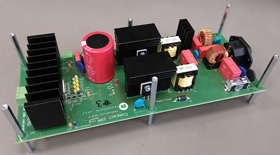

Electric motors are a powerhouse user of electricity worldwide, accounting for about two-thirds of industrial electricity consumption. The International Energy Agency reports that electric motors account for around 45% of total global power usage.
Thus, improving the efficiency of electric motor-driven systems has a significant impact on costs for industrial and other electricity consumers. One way to improve efficiency is to move away from fixed speed motors driven by the AC line voltage to variable speed motor drives where a three-phase inverter is used to generate the sinusoidal currents to turn the motor.
ON Semiconductor enables variable speed motor drives for many applications through its comprehensive portfolio of MOSFETs, IGBTs, gate drivers, op-amps and power supplies. The core topology, the three-phase inverter, is also available as a power module, which incorporates the six power switches and the gate drive circuits into a single package. ON Semiconductor’s intelligent power modules (IPMs) are perfect for applications ranging from watts to kilowatts.
The company recently released a new evaluation board, Compact Intelligent Power Module (IPM) Motor Drive, featuring the NFAQ1060L36T IPM in a DIPS6 package.
Taking a 230 V a.c. input, the board can deliver 850 W output power to a three-phase motor. The complete system design is on this board, with EMC filtering, input rectification, two-phase interleaved PFC, auxiliary power supplies and of course, the three-phase inverter with feedback and protection circuits.
The NFAQ1060L36T intelligent power module is a fully integrated power stage for a three-phase motor drive consisting of six IGBTs with reverse diodes, a high-voltage gate driver and a thermistor. The low-side IGBTs have open emitter terminals to allow the designer flexibility in choosing the current feedback topology and resolution.
The gate driver provides protection functions including shoot-through protection, under-voltage lockout and external shutdown. An internal comparator and reference connected to the over-current protection circuit allow the designer to set the over-current protection level. This device is suitable for industrial automation as well as industrial fans and pumps and appliances.
The interleaved PFC stage utilises several ON Semiconductor components: NCP1632 power factor controller, FCPF125N65S3 650V super-junction MOSFET and FFSPF1065A 650V SiC diode. The interleaved approach has several advantages such as the ease of implementation, the use of smaller components or a better distribution of the heating. It also extends the power range of critical conduction mode that is an efficient and cost-effective technique.
The NCP1632, whose drivers are 180° phase shifted for a significantly reduced current ripple, incorporates all the features necessary for building robust and compact interleaved PFC stages, with a minimum of external components.
This complete evaluation kit is rounded out by the NCS2250 high-speed comparator, NCS2003 high slew rate operational amplifier and NCP1063 high-voltage switcher which provide protection, feedback and auxiliary power, respectively.
An Arduino Due compatible header is the interface for the user to supply PWM signals to the inverter and to receive sense and fault information. If using an Arduino Due, simple code for motor V/f control in an open loop using space vector modulation is available. It allows one to set the phase voltage amplitude and frequency via a graphical user interface (GUI).
© Technews Publishing (Pty) Ltd | All Rights Reserved